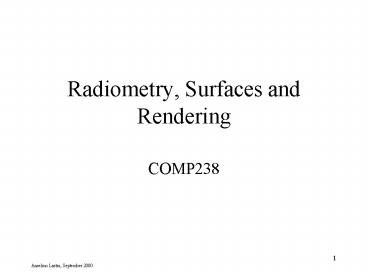Radiometry, Surfaces and Rendering - PowerPoint PPT Presentation
1 / 50
Title:
Radiometry, Surfaces and Rendering
Description:
To investigate formally some methods for physically-based realistic rendering ... No luminescence. Anselmo Lastra, September 2000. 8. Polarization. Ignore it ... – PowerPoint PPT presentation
Number of Views:33
Avg rating:3.0/5.0
Title: Radiometry, Surfaces and Rendering
1
Radiometry, Surfaces and Rendering
- COMP238
2
Goal
- To investigate formally some methods for
physically-based realistic rendering - Why physically based?
- What follows in course
3
Outline
- Radiometric Concepts
- Surface Properties
- Light Transport
4
Radiometry
- Science of measuring light
- Analogous science called photometry is based on
human perception.
5
Radiometric Quantities
- Function of wavelength, time, position,
direction, polarization.
6
Wavelength
- Assume wavelengths independent
- No phosphorescence
7
Time
- Equilibrium
- Light travels fast
- No luminescence
8
Polarization
- Ignore it
- Would likely need wave optics to simulate
9
Result five dimensions
- With little loss in usefulness
- Two quantities
- Position (3 components)
- Direction (2 components)
10
Radiant Energy - Q
- Think of photon as carrying quantum of energy
(hc/? where c is speed of light and h is Plancks
constant) - Total energy, Q, is then energy of the total
number of photons.
11
Power - ?
- Flow of energy (important for transport)
- Also called radiant flux.
- Energy per unit time (joules / s)
- Units watts
- ? dQ/dt
12
Radiant Flux Area Density
- This is a measure we need for energy
arriving/leaving a surface
dA
13
Radiant Flux Area Density
- Units of watts per meter squared
- Graphics doesnt use this term instead
14
Irradiance
- Power per unit area incident on a surface.
- E d ?/dA
- Units watts / m2
15
Radiant Exitance
- Radiant flux area density leaving surface
- Also known as Radiosity
- B d ?/dA
- Same units as irradiance, just direction changes.
16
What about a point source?
17
Intensity
- Flux per unit solid angle
- Units watts per steradian
- Note term intensity is heavily overloaded.
18
Solid Angle
- Size of a patch, dA, is
- Solid angle is
19
Isotropic Point Source
- Even distribution over sphere
20
Irradiance on Differential Patch
- This is the Square Law
x
?
xs
21
Projected Area
- Ap A (N V) A cos ?
V
N
V
?
22
Radiance
- Power per unit projected area per unit solid
angle. - Units watts per steradian m2
- We have now introduced projected area, a cosine
term.
23
Why the Cosine Term?
- Foreshortening is by cosine of angle.
- Radiance gives energy by effective surface area.
d cos?
?
d
24
Irradiance from Radiance
- cos? d? is projection of a differential area
25
Reciprocity
- Radiance from dS to dR
26
- Radiance from dS to dR (l is distance)
Projected area
Solid angle
27
Reciprocity
- Which is radiance from dS to dR
28
Total flux leaving one side flux arriving other
side, so
29
therefore
30
so
- Radiance doesnt change with distance!
31
Radiance at a sensor
- Sensor of a fixed area sees more of a surface
that is farther away. - However, the solid angle is inversely
proportional to distance. - Response of a sensor is proportional to radiance.
32
Radiance as a unit of measure
- Radiance doesnt change with distance
- Therefore its the quantity we want to measure in
a ray tracer. - Radiance proportional to what a sensor (camera,
eye) measures. - Therefore its what we want to output.
33
Photometry and Radiometry
- Photometry (begun 1700s by Bouguer) deals with
how humans perceive light. - All measurements relative to perception of
illumination - Units different from radiometric but conversion
is scale factor -- weighted by spectral response
of eye (over about 360 to 800 nm).
34
CIE curve
- Response is integral over all wavelengths
Violet
Green
Red
CIE, 1924, many more curves available, see
http//cvision.ucsd.edu/lumindex.htm
35
Photometric Units
- Talbot ? Joules
- Lumens ? Watt
- Nit, Lux, Candela
36
Radiometry
- Energy
- Power
- Irradiance and Radiosity
- Intensity
- Radiance
37
Surface Properties
- Reflected radiance is proportional to incoming
flux and to irradiance (incident power per unit
area).
38
Bidirectional Reflectance Distribution Function
(BRDF)
39
Dimensionality
- Function of position, four angles (two incident,
two reflected), as well as wavelength and
polarization (both usually ignored). - Material is usually considered uniform, so
position is ignored. - If isotropic, one angle goes away.
- Result - 3 or 4 dimensional.
40
Properties
- Reciprocity
41
Lambertian (diffuse) Surface
- BRDF is a constant.
- Independent of direction of incoming light.
- Radiosity over irradiance is constant.
42
Mirror (ideally specular) Surface
- Reflection on a plane perpendicular to surface.
- Angle of reflectance angle of incidence.
- BRDF cast as delta functions.
43
Glossy
- Between lambertian and specular.
44
Complex BRDF
- Combination of the three.
45
Representations
- 4D function, so awkward to represent directly.
- Most often represented as parametric equation
(Phong, Cook-Torrance, etc.). - Sometimes with basis functions (such as spherical
harmonics).
46
Rendering Equation
- Not from Kajiya 86 (more like Radiosity
equation). - Often approximated by splitting diffuse,
specular, and glossy.
47
Transport
- Now we have models of reflection.
- How do we transfer energy?
48
Transport Approximations
- Classical ray tracing
- Direct lambertian
- Global specular
- Radiosity
- Diffuse to diffuse global illumination
- View independent.
49
Next
- Formulation of Radiosity
- Practical aspects for computing a solution
50
References
- Chapter 2 (by Hanrahan) in Cohen and Wallace,
Radiosity and Realistic Image Synthesis. - Glassner, Principles of Digital Image Synthesis,
pp. 648 659 and Chapter 13. - Radiometry FAQ (PDF local, html remote)
- Bastos dissertation, Chapter 3 in
http//www.cs.unc.edu/bastos/PhD/2and3.pdf































